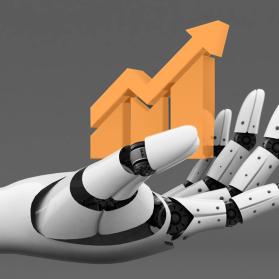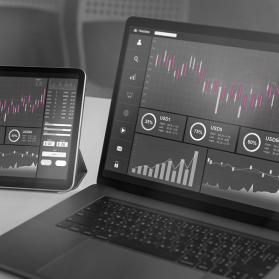Excerpt of an article by Steffen Kuhn and Dr. Igor Schnakenburg from the LÜNENDONK magazine "Artificial Intelligence".
Sixty percent of big data projects don't make it past their pilot and experimentation phase, Gartner has found. Why is that? And how can big data and AI algorithms be profitably deployed in the enterprise? One way: Data Thinking
The numbers often roll over when it comes to focus topics. On the one hand, AI solutions hold enormous potential for German companies, according to the undisputed mantra of a recent study by the eco association of the Internet industry. In 2025, they are expected to save around 330 billion euros in costs and make 150 billion euros more in revenue thanks to AI compared to 2019. Billions of euros, mind you. And according to a Lünendonk study, four out of five companies believe that AI will disruptively change their industry.
On the other hand, these figures do not contain any solution instructions: Which business models are enhanced or even enabled by data and algorithms, which projects can be implemented quickly and are relevant to practice, and how can the effort and benefits of different initiatives be compared?
For many reasons, AI projects, which are now generally a good thing everywhere, are often launched without a clear definition of goals or strategy. But important, somewhat more detailed core questions are then often not yet clarified: What problem is AI actually supposed to (re)solve? Where are inefficiencies in a process that can be identified or eliminated with the help of AI? What pays off for customers? Only when such questions have been intensively addressed and answers have been found should the development of a solution begin. Blind promises by any AI provider that they can solve one or all problems, on the other hand, should be met with skepticism.
Design Thinking, CRISP-Data Mining and Scrum
So far, there is no specific standard framework for the development of data-driven solution models. Common frameworks such as Design Thinking describe processes for unfolding optimal user orientation, creativity and innovation. The cross-industry standard process for data mining (CRISP-DM) describes the necessary processes for developing data-driven business models and solutions. Agility describes the ability to process project-related and cross-organizational tasks flexibly and at increased speed.
Since new business models are a triad of just innovation, data science and agility, a combination makes sense to combine the best of design thinking, CRISP-DM and agile development into a new framework. This ultimately ensures that "Data Projects" can be completed with a higher success rate. At Detecon, we call this superposition of approaches "Data Thinking".
In Data Thinking, the focus is no longer on technology or data alone, but on the joint development of business models that are innovative, create value and can also be implemented. To this end, a project team consisting of an innovation coach, representatives of the business units involved, and also data scientists and data engineers identifies the business need and designs several solution approaches. Based on various proofs of concept, implementation difficulties are already identified in Lab mode and can therefore be weighed up or resolved before implementation. In the same way, the implementation of a specific business model can also be put on hold for the time being (early fail). In this way, the data thinking approach significantly reduces the failure rate of data-driven projects.
Here is a practical example: Company marketers alone can hardly contribute creative ideas for customer support, or can do so only with difficulty, due to a lack of data science expertise ("How complicated is facial recognition?") or a lack of knowledge about innovation benchmarks ("Where are we in comparison to the competition?"). Innovation experts alone are also unable to do this, because they are just as unfamiliar with customer processes, needs and practices ("What interfaces does the company actually have with the customer?") as the data scientists ("What customer data is actually available?").
The complete article as well as the entire LÜNENDONK magazine "Artificial Intelligence" are available for download here. (in German only)








